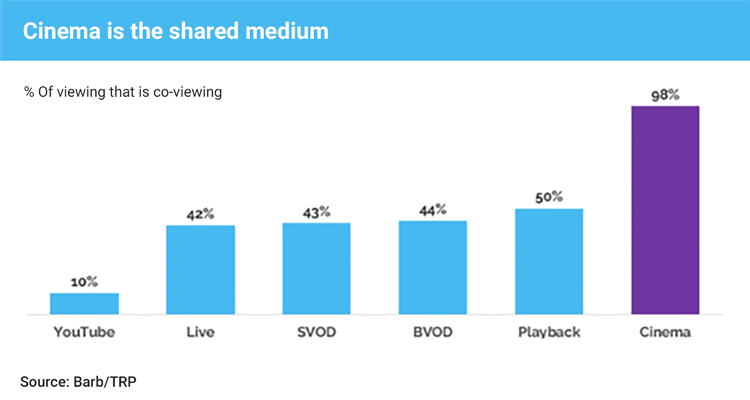
Co-viewing experiences in the film industry play a key role in forming social, cultural and commercial ties. A recent study published by Digital Cinema Media (DCM) in collaboration with Burst Your Bubble entitled “The Cultural Power of Cinema” highlights that 98% of cinema screenings are co-viewing experiences. This figure places cinema in a privileged position compared to other media such as television and streaming platforms such as YouTube, where shared viewing experiences are considerably lower.
The research highlights that, in a context of growing social isolation, especially among young adults, cinema is presented as a powerful tool to bring people together. Data such as 55% of adults agreeing that “there is no sense of community anymore” and 60% of 16-34 year olds feeling “distance from other people” underline the importance of these shared experiences. In turn, 71% of respondents stated that “being part of a large audience enhances the movie-going experience.” These numbers reveal the potential of cinema to combat social disconnection and isolation, creating moments of togetherness that are craved by much of the population.
In addition to its social function, cinema is also an attractive medium for brands. The report notes that 62% of moviegoers enjoy getting to the cinema early to watch ads and trailers, and 67% of 16-34 year olds say they enjoy talking about ads with others. This underscores cinema’s ability to generate moments of conversation around brands. Analyzing specific campaigns that screened in May and June 2024, DCM found that exposure to ads in cinema resulted in a significant increase in brands’ association with community (+50%), universalism (+106%) and brand fame (+12%).
Cinema, therefore, is not only an entertainment experience, but also a cultural and social space that can enhance the commercial impact of brands that choose to advertise in this medium. The perception of quality that the public associates with cinema also extends to the products and services advertised. A further 37% of respondents agreed that “if I use this brand, most people think I have made a good choice,” and an additional 21% associated brands with high quality products.
At a time when digital platforms and social media dominate the public’s attention, cinema remains a space that offers high-quality collective experiences, making it a unique medium. Unlike social networks, which the DCM study says “potentially drive isolation,” cinema stands as the “original social network” that fosters human connection in an authentic and tangible way. Cinema, more than any other medium, offers an environment in which shared experience is inherent, which has powerful communal effects. It is neither a virtual nor an individualistic experience, but an event that brings people together in the real world, which generates a feeling of closeness with others, something that other digital platforms cannot replicate.
The research also addresses technological innovations that are transforming the cinema co-viewing experience. For example, DCM is working on integrating anamorphic 3D and using artificial intelligence to create immersive cinema advertising experiences in formats such as Screen X, where screens span three walls for a 270-degree experience. These innovations have the potential to further deepen the emotional and social connection audiences experience at the cinema, offering brands new ways to connect with audiences in meaningful and memorable ways.
Cinema has proven to be a key cultural tool for strengthening social cohesion. By offering a shared experience, it promotes connection between people and creates a space for conversation and the exchange of ideas, something that is increasingly scarce in modern society. This cultural power, combined with the commercial opportunities it offers, makes cinema an essential medium for both brands and society as a whole.







